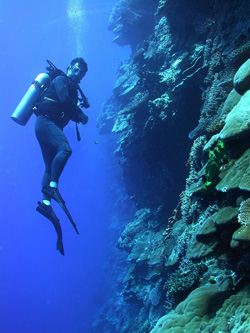Cayman Islands Twilight Zone 2007

CA diver explores the vertical distribution of corals on a Pacific wall.oral reefs and sunlight are almost synonymous in marine biology since most corals exist in an unusual symbiosis with microscopic plants called zooxanthellae. However, recent evidence indicates that light-limited deep coral reefs (between 50 and 150m: also known as the "Twilight Zone"¹) are an important transition habitat where many shallow-reef and deep-sea organisms coexist with each other and with species unique to this depth range. To date, deep-reefs worldwide have been examined almost exclusively using video photography from Remotely Operated Vehicles (ROVs) since these communities are deeper than the typical safety limits of SCUBA divers. Recent advances in technical diving procedures have made it safe and practical to explore the deep reefs in person. We have assembled a team of highly trained technical divers and support divers to mount an expedition into the Twilight Zone of the Cayman Islands.
In the Cayman Islands, unusual sponges and soft corals cling to nearly vertical walls that drop into the abyss of the Cayman Trench 7500m below the crystal-clear surface waters. Identifying the biodiversity and health status of these important transition communities is the first step towards effective management and conservation of these deep-reef habitats. We will also characterize the physical environment of these deep reefs to better understand how factors like water-flow, nutrients, temperature and light control the distribution of deep-reef species. In addition, we will explore the connectivity between the deep- and shallow-reefs to determine whether organisms from these Twilight Zone communities can "reseed" degraded shallow reefs. Finally, biological adaptations of these organisms make them excellent candidates for biotechnology research efforts, and we will look at their potential to produce new drugs from the sea.
This research is a collaborative effort between the University of Mississippi, the University of New Hampshire, and the University of Alabama. We are supported with funding from NOAA's Ocean Exploration program, and from the National Institute of Undersea Science & Technology's Ocean Biotechnology Center & Repository. The Little Cayman Research Center provides on-site logistical support, and the Cayman Islands Department of Environment, and the Marine Conservation Board, have graciously provided permits to explore their reefs.
 Deep Sea Crabs
Deep Sea Crabs